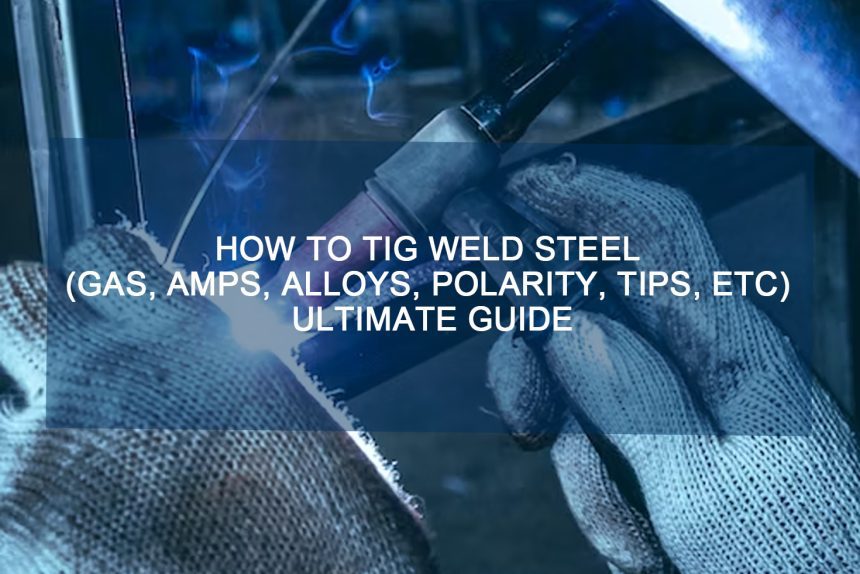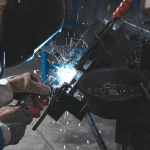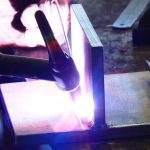TIG welding, also known as Tungsten Inert Gas welding, is a highly valuable method for joining metals, especially steel. This technique involves heating the metals using an arc created between the tungsten electrode and the base metal.
How to TIG Weld Steel
Welding Town
(Gas, Amps, Alloys, Polarity, Tips, etc)
Ultimate Guide
How to TIG Weld Mild Steel?
Mild steel is a type of steel alloy that contains a lower percentage of carbon, typically 0.3 percent or less, which earns it the name “low carbon steel.” This material is widely used in fabrication due to its cost-effectiveness compared to other alloys and its ease of welding. Tungsten inert gas (TIG) welding is a commonly used method for welding mild steel, resulting in clean and precise welds.
Mild steel offers numerous advantages, including its weldability and the ability to be easily shaped and molded. These attributes make it a popular choice for many welders. However, it is important to select the appropriate filler metal for your specific application, as the features of mild steel may vary depending on the material type. Generally, mild steels have less strength when compared to low-alloy steels.
The ease of weldability and absence of additional elements make mild steel an affordable option for constructing durable structures. It serves as an excellent starting material for new welders due to its straightforward welding characteristics. However, TIG welding requires more finesse and concentration compared to processes like oxy-acetylene torch welding or metal inert gas welding. It is essential to ensure that both the workpieces and the welding rod are clean before welding mild steel, as any contaminants can adversely affect the weld quality.
How to TIG Weld Cast Iron/Steel?
Welding cast iron can be challenging, but it is certainly feasible. In most cases, welding on cast iron involves repairing existing castings rather than joining cast iron to other components. Understanding the intricacies of welding cast iron is crucial for successful repairs. Typically, cast iron contains a carbon content of 2% to 4%, which is significantly higher than that found in many steels, making it more difficult to weld.When it comes to welding cast iron steel, below are four simple steps must be taken out before obtaining started:
- Predict an alloy
- Clean the casting carefully
- Choose the pre-heat temperature
- Choose a suitable welding procedure
Before commencing the welding process, it is essential to select the appropriate polarity based on factors such as the filler material, specific requirements, base material, and electrode type. Choosing the right polarity ensures optimal welding performance and results.However, the parameters generally affected by tig polarity are including:
- Filler deposition
- Base plate cleaning
- Weld penetration
- Weld bead look
- Reinforcement
- Heat affected zone
- TIG Welding On Stainless Steel
The welding process for stainless steel varies depending on its thickness. It is crucial to consider the desired characteristics of the finished product before proceeding with the weld. Various welding procedures exist for stainless steel and are commonly employed by welders. Hence, it is essential to select the most suitable method based on the specific qualities you are seeking in the welded joint. Below are some of the common methods for welding stainless steel that includes:
- Tig welding or gas tungsten arc
- Mig welding or gas metal AC welding
- Resistance or spot welding
When it comes to TIG welding on stainless steel, there are several recommendations to consider. Similar to TIG welding on regular steel, achieving a proper balance between travel speed and amperage is essential. Ideally, you should position the electrode close to the puddle and maintain a high travel speed. This approach helps minimize discoloration and reduces the size of the heat-affected zone. By maintaining a high travel speed, even if using a higher number of amps, excessive heat transfer to the welding area can be avoided. If you are unsure about your ability to weld quickly enough, it is advisable to lower the amperage to ensure better control over the welding process.
I always recommend conducting test welds before proceeding with the desired connection, as the size of the weld plays a crucial role. It is advisable to begin with approximately 100 amps and make necessary adjustments based on the factors discussed in the previous paragraph. By altering these factors, such as travel speed and amperage, you can calibrate the welding parameters to achieve the desired weld quality and characteristics.




![12 Different Types of Welding Processes [The Definitive Guide] 6 12 Different Types of Welding Processes [The Definitive Guide]](https://www.021208.com/wp-content/uploads/2025/01/12-Different-Types-of-Welding-Processes-The-Definitive-Guide-150x150.jpg)







